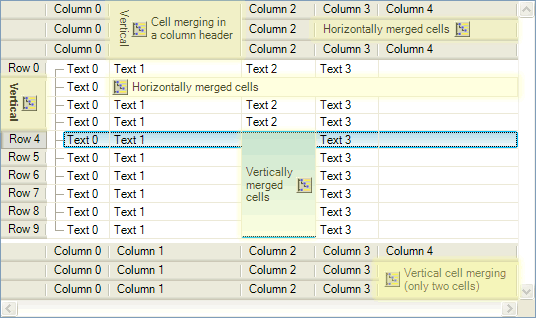![]()
Cell Merging
|
|
|
|
|
|
Cell Merging |
The contents of a cell can merge into an adjacent cell (on the right or below), if suitably configured. Cell merging is specific to the control being used.
If a cell is empty or has the same cell text as the previous cell (or upper cell), it will allow the previous cell (or upper cell) to merge with it, so that cell can use the combined space. For a cell to merge into the next cell (or lower cell), the MergeWithNext (or MergeWithLower) property must be set to True. At the same time, the next cell (or lower cell) must have its AllowMergeFromPrevious (or AllowMergeFromUpper) property set to True.
A merged cell continues to merge into adjacent cells as long as these are suitable defined (AllowMergeFromPrevious or AllowMergeFromUpper) and the cell is empty or has the same cell text.
The first cell that starts a group of merged cells is considered the main cell. All other cells that are within the same group of merged cells are subordinate cells. Any cell can locate its main cell using the MainCell property.
SftTree/NET 2.0: Intersecting vertically and horizontally merged cells are not supported.

SftTree/NET 2.0: Cell merging is supported in all areas of the tree control, item area, row header area, column headers and column footers. The default settings for cell merging can be defined using these properties: Headers.AllowMergeFromUpperDefault for column headers, Footers.AllowMergeFromUpperDefault for column footers, RowHeaders.AllowMergeFromUpperDefault and ColumnClass.AllowMergeFromUpperDefault for each column.
SftTree/NET 2.0: The control's MergeStyle property determines whether empty cells or cells with the same cell text are candidates for cell merging for vertical cell merging. Horizontal cell merging is always based on empty cells only.
Cell merging is not used in this product. Properties and methods used with cell merging have no effect.